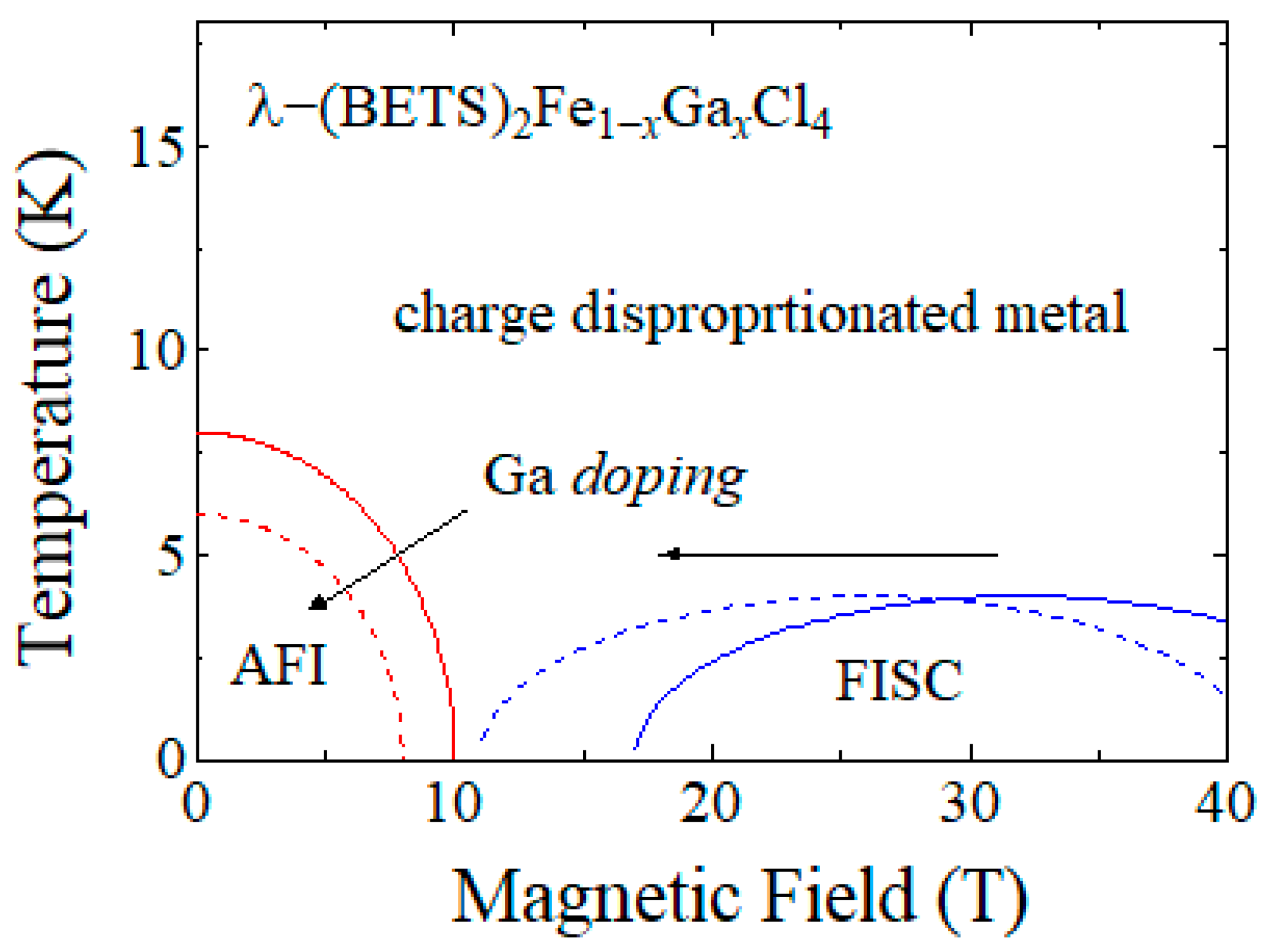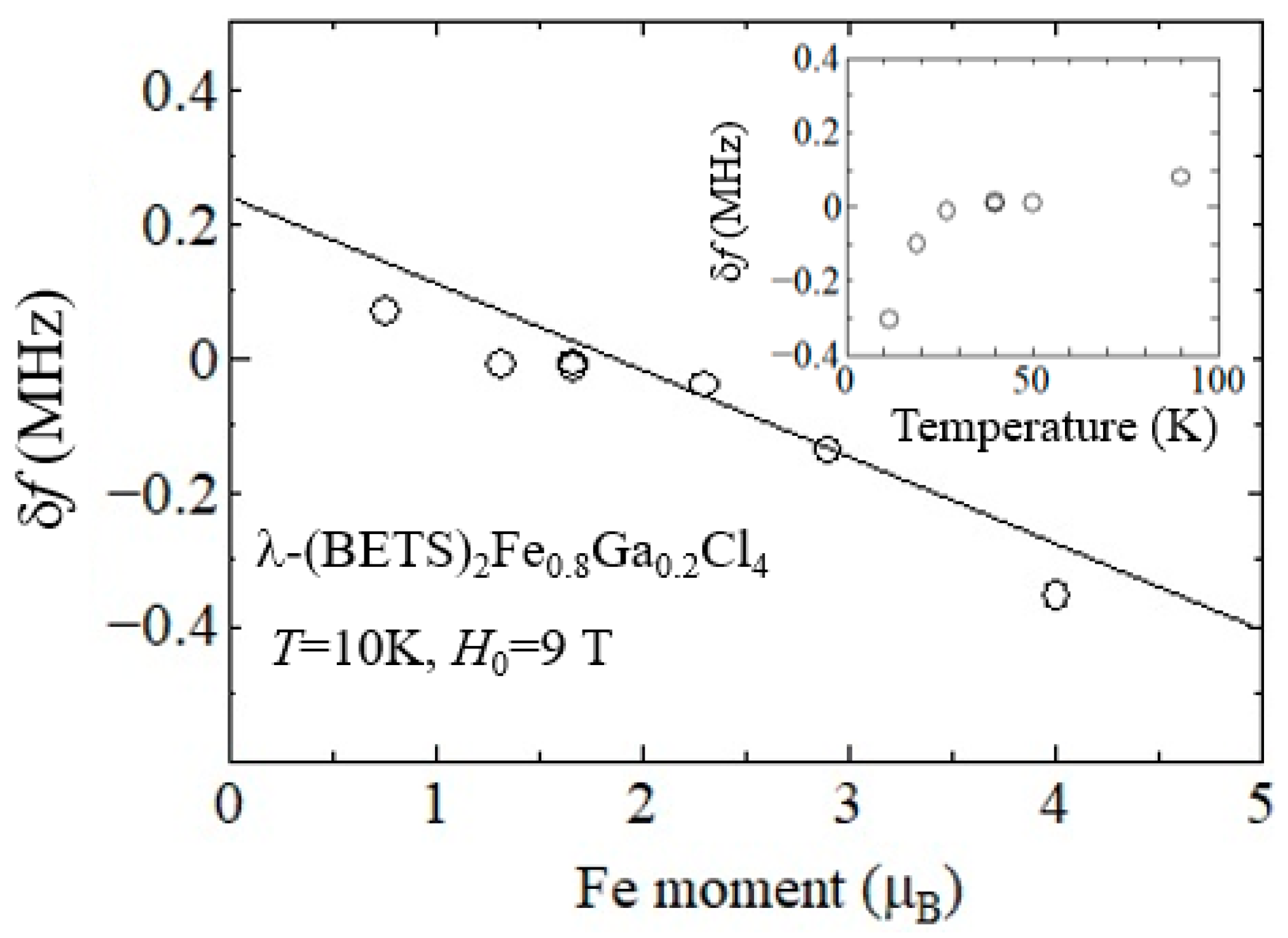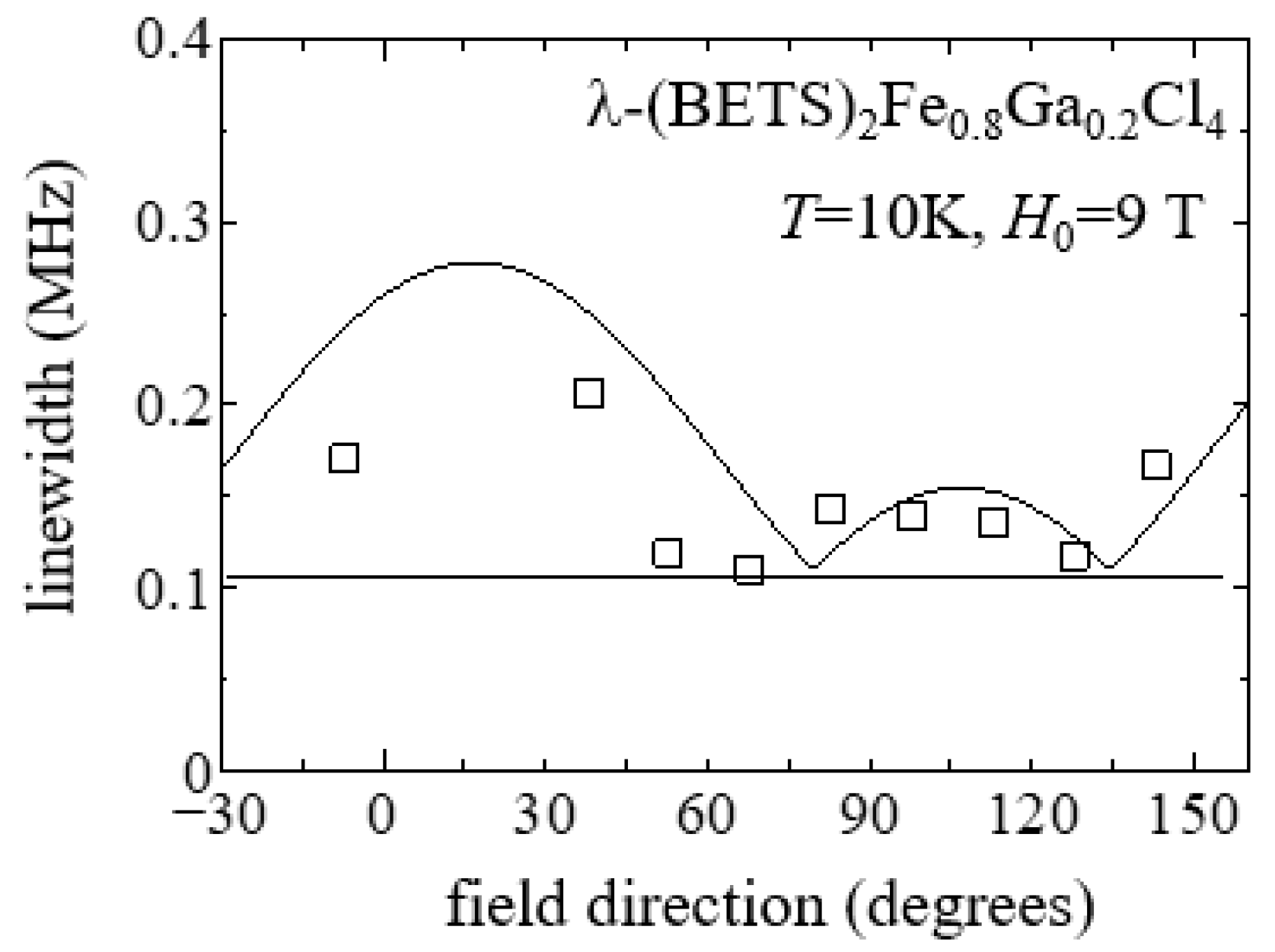Microscopic Observation of π Spin Polarization by d Localized Spin in λ Type BETS Based Organic Superconductors
Abstract
1. Introduction
2. Experimental Details
3. Results and Discussion
3.1. Evaluation of the Exchange Interaction
3.2. Linewidth Analysis: Charge Disproportionation
4. Conclusions
Author Contributions
Funding
Acknowledgments
Conflicts of Interest
References
- Kobayashi, H.; Cui, H.-B.; Kobayashi, A. Organic Metals and Superconductors Based on BETS (BETS = Bis(ethylenedithio)tetraselenafulvalene). Chem. Rev. 2004, 104, 5265–5288. [Google Scholar] [CrossRef] [PubMed]
- Kobayashi, H.; Tomita, H.; Naito, T.; Kobayashi, A.; Sakai, F.; Watanabe, T.; Cassoux, P. New BETS Conductors with Magnetic Anions (BETS = bis(ethylenedithio)tetraselenafulvalene). J. Am. Chem. Soc. 1996, 118, 368–377. [Google Scholar] [CrossRef]
- Tokumoto, M.; Naito, T.; Kobayashi, H.; Kobayashi, A.; Laukhin, V.N.; Brossard, L.; Cassoux, P. Magnetic anisotropy of organic conductor λ-(BETS)2FeCl4. Synth. Met. 1997, 86, 2161–2162. [Google Scholar] [CrossRef]
- Brossard, L.; Clerac, R.; Coulon, C.; Tokumoto, M.; Ziman, T.D.; Petrov, K.; Laukhin, V.N.; Naughton, M.J.; Audouard, A.; Goze, F.; et al. Interplay between chains of S = 5/2 localised spins and two-dimensional sheets of organic donors in the synthetically built magnetic multilayer λ−(BETS)2FeCl4. Eur. Phys. J. 1998, 1, 439–452. [Google Scholar] [CrossRef]
- Akiba, H.; Nakano, S.; Nishio, Y.; Kajita, K.; Zhou, B.; Kobayashi, A.; Kobayashi, H. Mysterious Paramagnetic States of Fe 3d Spin in Antiferromagnetic Insulator of λ-BETS2FeCl4 System. J. Phys. Soc. Jpn. 2009, 78, 033601. [Google Scholar] [CrossRef]
- Oshima, Y.; Cui, H.-B.; Kato, R. Antiferromagnetic Insulating Ground State of Molecular π-d System λ-(BETS)2FeCl4 (BETS = Bis(ethylenedithio)tetraselenafulvalene): A Theoretical and Experimental Review. Magnetochemistry 2017, 3, 10. [Google Scholar] [CrossRef]
- Uji, S.; Shinagawa, H.; Terashima, T.; Yakabe, T.; Terai, Y.; Tokumoto, M.; Kobayashi, A.; Tanaka, H.; Kobayashi, H. Magnetic-field-induced superconductivity in a two-dimensional organic conductor. Nature 2001, 410, 908–910. [Google Scholar] [CrossRef]
- Balicas, L.; Brooks, L.S.; Storr, K.; Uji, S.; Tokumoto, M.; Tanaka, H.; Kobayashi, H.; Kobayashi, A.; Barzykin, V.; Gor’kov, L.P. Superconductivity in an Organic Insulator at Very High Magnetic Fields. Phys. Rev. Lett. 2001, 87, 067002. [Google Scholar] [CrossRef]
- Jaccarino, V.; Peter, M. Ultra High Field Superconductivity. Phys. Rev. Lett. 1962, 9, 290–292. [Google Scholar] [CrossRef]
- Uji, S.; Terakura, C.; Terashima, T.; Yakabe, T.; Terai, Y.; Tokumoto, M.; Kobayashi, A.; Sakai, F.; Tanaka, H.; Kobayashi, H. Fermi surface and internal magnetic field of the organic conductors λ-(BETS)2FexGa1−xCl4. Phys. Rev. B 2002, 65, 113101. [Google Scholar] [CrossRef]
- Wu, G.; Clark, W.G.; Brown, S.E.; Brooks, J.S.; Kobayashi, A.; Kobayashi, H. 77Se NMR measurements of the π-d exchange field in the organic conductor λ-(BETS)2FeCl4. Phys. Rev. B 2007, 76, 132510. [Google Scholar] [CrossRef]
- Hiraki, K.; Mayaffre, H.; Horvati, M.C.; Berthier, C.; Tanaka, H.; Kobayashi, A.; Kobayashi, H.; Takahashi, T. π-d Interaction in the Field Induced Superconductor λ-(BETS)2FeCl4: Studied by 77Se NMR. J. Low Temp. Phys. 2006, 142, 185–190. [Google Scholar] [CrossRef]
- Hiraki, K.; Mayaffre, H.; Horvati, M.C.; Berthier, C.; Yamaguchi, T.; Uji, S.; Tanaka, H.; Kobayashi, A.; Kobayashi, H.; Takahashi, T. 77Se NMR evidence for the Jaccarino-Peter mechanism in the field induced superconductor, λ(BETS)2FeCl4. J. Phys. Soc. Jpn. 2007, 76, 124708. [Google Scholar] [CrossRef]
- Uji, S.; Brooks, J.S. Magnetic-Field-Induced Superconductivity in Organic Conductors. J. Phys. Soc. Jpn. 2006, 75, 051014. [Google Scholar] [CrossRef]
- Tanaka, H.; Kobayashi, A.; Sato, A.; Akutsu, H.; Kobayashi, H. Chemical Control of Electrical Properties and Phase Diagram of a Series of λ-Type BETS Superconductors, λ-(BETS)2GaBrxCl4−x. J. Am. Chem. Soc. 1999, 121, 760–768. [Google Scholar] [CrossRef]
- Tanatar, M.A.; Ishiguro, T.; Tanaka, H.; Kobayashi, A.; Kobayashi, H. Anisotropy of the Upper Critical Field of the Organic Superconductor λ-(BETS)2GaCl4. J. Supercond. 1997, 12, 511–514. [Google Scholar] [CrossRef]
- Uji, S.; Terashima, T.; Terakura, C.; Yakabe, T.; Terai, Y.; Yasuzuka, S.; Imanaka, Y.; Tokumoto, M.; Kobayashi, A.; Sakai, F.; et al. Global Phase Diagram of the Magnetic Field-Induced Organic Superconductors λ-(BETS)2FexGa1−xCl4. J. Phys. Soc. Jpn. 2003, 72, 369–373. [Google Scholar] [CrossRef]
- Oshima, Y.; Nojiri, H.; Uji, S.; Brooks, J.S.; Tokumoto, T.; Cui, H.; Kato, R. Breakdown of the field-induced superconductivity by dynamical spin reversal. Phys. Rev. B 2012, 86, 024525. [Google Scholar] [CrossRef]
- Akiba, H.; Sugawara, H.; Nobori, K.; Shimada, K.; Tajima, N.; Nishio, Y.; Kajita, K.; Zhou, B.; Kobayashi, A.; Kobayashi, H. Paramagnetic Metal–Antiferromagnetic Insulator Transition of λ-BETS2FexGa1−xCl4 System. J. Phys. Soc. Jpn. 2012, 81, 053601. [Google Scholar] [CrossRef]
- Hiraki, K.; Kitahara, M.; Takahashi, T.; Mayaffre, H.; Horvatic, M.; Berthier, C.; Uji, S.; Tanaka, H.; Zhou, B.; Kobayashi, A.; et al. Evidence of Charge Disproportionation in λ Type BETS Based Organic Superconductors. J. Phys. Soc. Jpn. 2010, 79, 074711. [Google Scholar] [CrossRef]




Publisher’s Note: MDPI stays neutral with regard to jurisdictional claims in published maps and institutional affiliations. |
© 2020 by the authors. Licensee MDPI, Basel, Switzerland. This article is an open access article distributed under the terms and conditions of the Creative Commons Attribution (CC BY) license (http://creativecommons.org/licenses/by/4.0/).
Share and Cite
Hiraki, K.-i.; Takahashi, T.; Akiba, H.; Nishio, Y.; Zhou, B. Microscopic Observation of π Spin Polarization by d Localized Spin in λ Type BETS Based Organic Superconductors. Crystals 2020, 10, 1055. https://doi.org/10.3390/cryst10111055
Hiraki K-i, Takahashi T, Akiba H, Nishio Y, Zhou B. Microscopic Observation of π Spin Polarization by d Localized Spin in λ Type BETS Based Organic Superconductors. Crystals. 2020; 10(11):1055. https://doi.org/10.3390/cryst10111055
Chicago/Turabian StyleHiraki, Ko-ichi, Toshihiro Takahashi, Hiroshi Akiba, Yutaka Nishio, and Biao Zhou. 2020. "Microscopic Observation of π Spin Polarization by d Localized Spin in λ Type BETS Based Organic Superconductors" Crystals 10, no. 11: 1055. https://doi.org/10.3390/cryst10111055
APA StyleHiraki, K.-i., Takahashi, T., Akiba, H., Nishio, Y., & Zhou, B. (2020). Microscopic Observation of π Spin Polarization by d Localized Spin in λ Type BETS Based Organic Superconductors. Crystals, 10(11), 1055. https://doi.org/10.3390/cryst10111055





